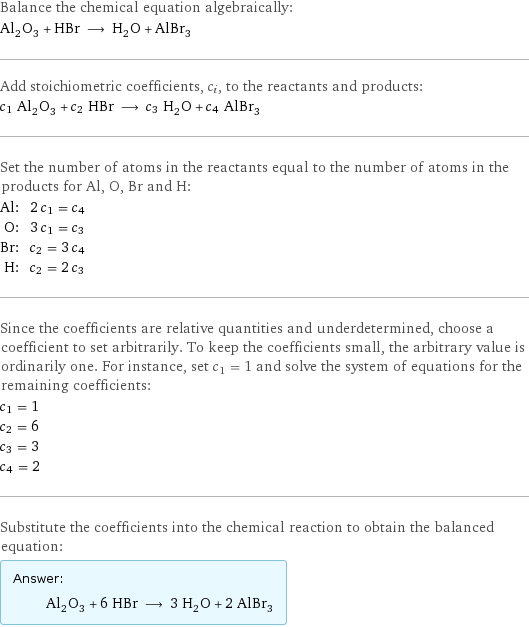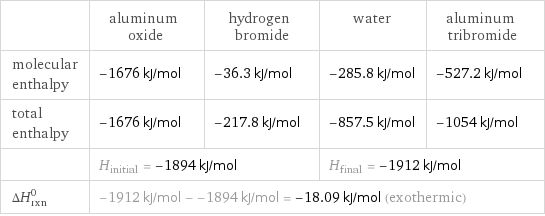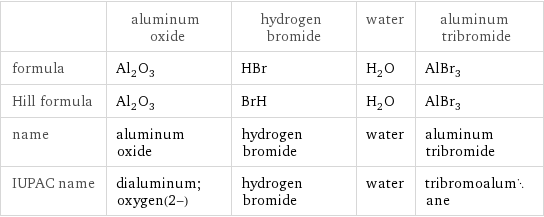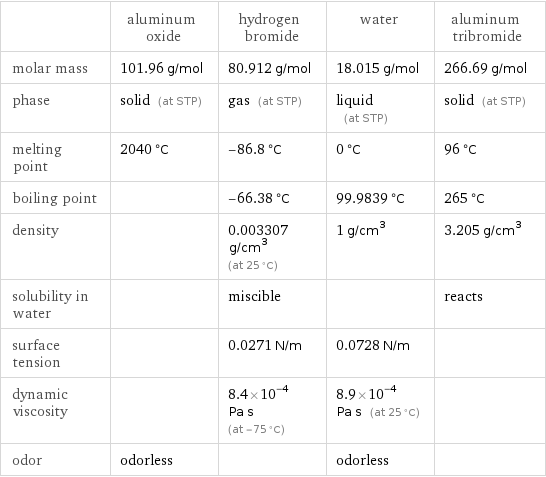Input interpretation

Al_2O_3 aluminum oxide + HBr hydrogen bromide ⟶ H_2O water + AlBr_3 aluminum tribromide
Balanced equation

Balance the chemical equation algebraically: Al_2O_3 + HBr ⟶ H_2O + AlBr_3 Add stoichiometric coefficients, c_i, to the reactants and products: c_1 Al_2O_3 + c_2 HBr ⟶ c_3 H_2O + c_4 AlBr_3 Set the number of atoms in the reactants equal to the number of atoms in the products for Al, O, Br and H: Al: | 2 c_1 = c_4 O: | 3 c_1 = c_3 Br: | c_2 = 3 c_4 H: | c_2 = 2 c_3 Since the coefficients are relative quantities and underdetermined, choose a coefficient to set arbitrarily. To keep the coefficients small, the arbitrary value is ordinarily one. For instance, set c_1 = 1 and solve the system of equations for the remaining coefficients: c_1 = 1 c_2 = 6 c_3 = 3 c_4 = 2 Substitute the coefficients into the chemical reaction to obtain the balanced equation: Answer: | | Al_2O_3 + 6 HBr ⟶ 3 H_2O + 2 AlBr_3
Structures

+ ⟶ +
Names

aluminum oxide + hydrogen bromide ⟶ water + aluminum tribromide
Reaction thermodynamics
Enthalpy

| aluminum oxide | hydrogen bromide | water | aluminum tribromide molecular enthalpy | -1676 kJ/mol | -36.3 kJ/mol | -285.8 kJ/mol | -527.2 kJ/mol total enthalpy | -1676 kJ/mol | -217.8 kJ/mol | -857.5 kJ/mol | -1054 kJ/mol | H_initial = -1894 kJ/mol | | H_final = -1912 kJ/mol | ΔH_rxn^0 | -1912 kJ/mol - -1894 kJ/mol = -18.09 kJ/mol (exothermic) | | |
Equilibrium constant
![Construct the equilibrium constant, K, expression for: Al_2O_3 + HBr ⟶ H_2O + AlBr_3 Plan: • Balance the chemical equation. • Determine the stoichiometric numbers. • Assemble the activity expression for each chemical species. • Use the activity expressions to build the equilibrium constant expression. Write the balanced chemical equation: Al_2O_3 + 6 HBr ⟶ 3 H_2O + 2 AlBr_3 Assign stoichiometric numbers, ν_i, using the stoichiometric coefficients, c_i, from the balanced chemical equation in the following manner: ν_i = -c_i for reactants and ν_i = c_i for products: chemical species | c_i | ν_i Al_2O_3 | 1 | -1 HBr | 6 | -6 H_2O | 3 | 3 AlBr_3 | 2 | 2 Assemble the activity expressions accounting for the state of matter and ν_i: chemical species | c_i | ν_i | activity expression Al_2O_3 | 1 | -1 | ([Al2O3])^(-1) HBr | 6 | -6 | ([HBr])^(-6) H_2O | 3 | 3 | ([H2O])^3 AlBr_3 | 2 | 2 | ([AlBr3])^2 The equilibrium constant symbol in the concentration basis is: K_c Mulitply the activity expressions to arrive at the K_c expression: Answer: | | K_c = ([Al2O3])^(-1) ([HBr])^(-6) ([H2O])^3 ([AlBr3])^2 = (([H2O])^3 ([AlBr3])^2)/([Al2O3] ([HBr])^6)](../image_source/95e30640e61ec91eda75ce114841e5db.png)
Construct the equilibrium constant, K, expression for: Al_2O_3 + HBr ⟶ H_2O + AlBr_3 Plan: • Balance the chemical equation. • Determine the stoichiometric numbers. • Assemble the activity expression for each chemical species. • Use the activity expressions to build the equilibrium constant expression. Write the balanced chemical equation: Al_2O_3 + 6 HBr ⟶ 3 H_2O + 2 AlBr_3 Assign stoichiometric numbers, ν_i, using the stoichiometric coefficients, c_i, from the balanced chemical equation in the following manner: ν_i = -c_i for reactants and ν_i = c_i for products: chemical species | c_i | ν_i Al_2O_3 | 1 | -1 HBr | 6 | -6 H_2O | 3 | 3 AlBr_3 | 2 | 2 Assemble the activity expressions accounting for the state of matter and ν_i: chemical species | c_i | ν_i | activity expression Al_2O_3 | 1 | -1 | ([Al2O3])^(-1) HBr | 6 | -6 | ([HBr])^(-6) H_2O | 3 | 3 | ([H2O])^3 AlBr_3 | 2 | 2 | ([AlBr3])^2 The equilibrium constant symbol in the concentration basis is: K_c Mulitply the activity expressions to arrive at the K_c expression: Answer: | | K_c = ([Al2O3])^(-1) ([HBr])^(-6) ([H2O])^3 ([AlBr3])^2 = (([H2O])^3 ([AlBr3])^2)/([Al2O3] ([HBr])^6)
Rate of reaction
![Construct the rate of reaction expression for: Al_2O_3 + HBr ⟶ H_2O + AlBr_3 Plan: • Balance the chemical equation. • Determine the stoichiometric numbers. • Assemble the rate term for each chemical species. • Write the rate of reaction expression. Write the balanced chemical equation: Al_2O_3 + 6 HBr ⟶ 3 H_2O + 2 AlBr_3 Assign stoichiometric numbers, ν_i, using the stoichiometric coefficients, c_i, from the balanced chemical equation in the following manner: ν_i = -c_i for reactants and ν_i = c_i for products: chemical species | c_i | ν_i Al_2O_3 | 1 | -1 HBr | 6 | -6 H_2O | 3 | 3 AlBr_3 | 2 | 2 The rate term for each chemical species, B_i, is 1/ν_i(Δ[B_i])/(Δt) where [B_i] is the amount concentration and t is time: chemical species | c_i | ν_i | rate term Al_2O_3 | 1 | -1 | -(Δ[Al2O3])/(Δt) HBr | 6 | -6 | -1/6 (Δ[HBr])/(Δt) H_2O | 3 | 3 | 1/3 (Δ[H2O])/(Δt) AlBr_3 | 2 | 2 | 1/2 (Δ[AlBr3])/(Δt) (for infinitesimal rate of change, replace Δ with d) Set the rate terms equal to each other to arrive at the rate expression: Answer: | | rate = -(Δ[Al2O3])/(Δt) = -1/6 (Δ[HBr])/(Δt) = 1/3 (Δ[H2O])/(Δt) = 1/2 (Δ[AlBr3])/(Δt) (assuming constant volume and no accumulation of intermediates or side products)](../image_source/280bc3e9001ddea8cdfe21bcfe30bf0f.png)
Construct the rate of reaction expression for: Al_2O_3 + HBr ⟶ H_2O + AlBr_3 Plan: • Balance the chemical equation. • Determine the stoichiometric numbers. • Assemble the rate term for each chemical species. • Write the rate of reaction expression. Write the balanced chemical equation: Al_2O_3 + 6 HBr ⟶ 3 H_2O + 2 AlBr_3 Assign stoichiometric numbers, ν_i, using the stoichiometric coefficients, c_i, from the balanced chemical equation in the following manner: ν_i = -c_i for reactants and ν_i = c_i for products: chemical species | c_i | ν_i Al_2O_3 | 1 | -1 HBr | 6 | -6 H_2O | 3 | 3 AlBr_3 | 2 | 2 The rate term for each chemical species, B_i, is 1/ν_i(Δ[B_i])/(Δt) where [B_i] is the amount concentration and t is time: chemical species | c_i | ν_i | rate term Al_2O_3 | 1 | -1 | -(Δ[Al2O3])/(Δt) HBr | 6 | -6 | -1/6 (Δ[HBr])/(Δt) H_2O | 3 | 3 | 1/3 (Δ[H2O])/(Δt) AlBr_3 | 2 | 2 | 1/2 (Δ[AlBr3])/(Δt) (for infinitesimal rate of change, replace Δ with d) Set the rate terms equal to each other to arrive at the rate expression: Answer: | | rate = -(Δ[Al2O3])/(Δt) = -1/6 (Δ[HBr])/(Δt) = 1/3 (Δ[H2O])/(Δt) = 1/2 (Δ[AlBr3])/(Δt) (assuming constant volume and no accumulation of intermediates or side products)
Chemical names and formulas

| aluminum oxide | hydrogen bromide | water | aluminum tribromide formula | Al_2O_3 | HBr | H_2O | AlBr_3 Hill formula | Al_2O_3 | BrH | H_2O | AlBr_3 name | aluminum oxide | hydrogen bromide | water | aluminum tribromide IUPAC name | dialuminum;oxygen(2-) | hydrogen bromide | water | tribromoalumane
Substance properties

| aluminum oxide | hydrogen bromide | water | aluminum tribromide molar mass | 101.96 g/mol | 80.912 g/mol | 18.015 g/mol | 266.69 g/mol phase | solid (at STP) | gas (at STP) | liquid (at STP) | solid (at STP) melting point | 2040 °C | -86.8 °C | 0 °C | 96 °C boiling point | | -66.38 °C | 99.9839 °C | 265 °C density | | 0.003307 g/cm^3 (at 25 °C) | 1 g/cm^3 | 3.205 g/cm^3 solubility in water | | miscible | | reacts surface tension | | 0.0271 N/m | 0.0728 N/m | dynamic viscosity | | 8.4×10^-4 Pa s (at -75 °C) | 8.9×10^-4 Pa s (at 25 °C) | odor | odorless | | odorless |
Units
